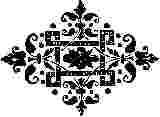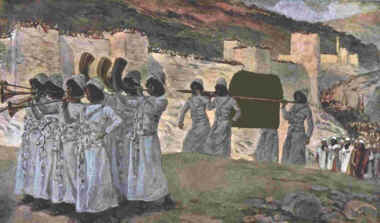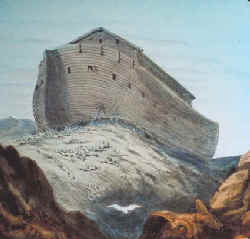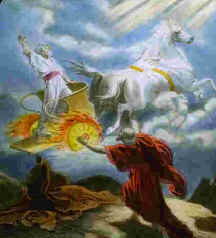THE STORY OF THE
"SEVEN LAST PLAGUES"
| TABLE OF CONTENTS |
|
Part
I Another Sign
in Heaven
Victory Over
the Beast and Image
Two Songs of Moses
The "Image" Becomes History |
|
Part
II The Temple
and the Tabernacle
Seven Angels
Golden Bowls
Filled with God's Glory
The Tabernacle
Solomon's Temple
Ezekiel's Temple
|
|
Part
III 7 Last Plagues
1st Plague
2nd Plague
3rd Plague
4th Plague
5th Plague
6th Plague
7th Plague
|
|
Part
IV
Who Pours the Bowls
Fall of Jericho
The Elijah Type |

PART IV
Who Pours the Bowls?
Now the question—
Who pours out the
"vials [bowls]" containing the "seven plagues" of Revelation?
Revelation says the "seven angels" pour out their
"vials" or bowls. The "seven angels" are in all probability seven
messages, which contain "plague" producing truths. A message cannot pour itself
out. The language is veiled here for a good reason.
One thing is certain—it
is not the Great Company who pours out the "plagues." The "seven angels"
come out of the "Temple." The
Great Company is not a part of the "Temple." One reason some may feel it is the
Great Company is because they feel that when the "Temple" is filled with
God’s glory, then all the saints are on the other side of the veil.
In some places Bro. Russell expressed that view. However,
on Reprint
5714 he says regarding Solomon's Temple which was dedicated while still incomplete:
"The fact that the typical Temple was filled with the glory of the Lord
before it was entirely completed seems to imply that at this present time there will be
some manifestation of God's favor toward His church in glorification while yet the
work of construction is not quite finished."
We understand this to allow for some saints to be on this side of the
veil when God's glory fills His "Temple."
In Ezekiel's "temple," God's glory fills the
"Temple" when the Lord enters through the "East
Gate" and then later,
when the Lord enters through the "North
Gate." This seems to indicate two stages
of glory.
(1) With some sealed
saints still on this side of the veil.
(2) When all the saints
are glorified.
Revelation 19 speaks of our Lord appearing on a "white
horse" to judge and make war. He is said to have "armies" (plural)
in
heaven in "fine linen" who also follow him on "white horses." Bro.
Russell observed in order for there to be "armies" (plural), there would need to
be at least two parts—one on this side of the veil and one on the other.
When the war does ensue, the papal "beast" and the
"kings of the earth" make war against his "army" (singular). They
apparently attack the weakest flank, the saints on this side of the veil. See Revelation
19:11-20; Reprint 5451.
Revelation 16 leaves the impression that the "seven
angels" or seven messages go forth themselves with the bowls without any active
agent. Why? There is good reason for this. In Revelation 15:6 we read again:
"And the seven angels
[messages] came out of the
Temple,
having the seven plagues, clothed in pure and white linen, and having their breasts girded
with golden girdles [divine servitude]."
The whole "Temple" class takes responsibility for pouring
out these judgmental "plagues."
The
Scriptures credit only the "Temple" and its Lord for
delivering these awesome "plagues." The messages come out of the
"Temple." The whole church or "Temple" class takes responsibility for
this, as we read in Psalms 149:5-9:
"Let the saints be
joyful in glory: let them sing aloud upon their beds
[on their beds of faith].
"Let the high praises of God be in their mouth, and a two-edged sword in
their hand;
"To execute vengeance upon the heathen, and punishments upon the people;
"To bind their kings with chains, and their nobles with fetters of iron;
"To execute upon them the judgment written: this honor have all his
saints. Praise ye the Lord"
Bro. Russell applies these verses to the saints on this side of the
veil. (Reprint 5631; 5451; Question Book, 387.)
The whole "Temple" class, under the supervision of our
Lord and Head, directs these seven last messages which contain the seven last
"plagues." Only the Lord's army on this side of the veil will act as
mouthpieces. But solidly behind them is the King of Kings and Lord of Lords and all the
other "Temple" members in glory.
This will be the first time the whole "Temple" class will act
as one body. So it is a great moment in God's plan. Thereafter, the whole body will always
act in unison.
|

Gideon's Band |
The evidence seems to indicate that a small body of
"sealed saints" will represent the whole "Temple" class in glory
"pouring out the seven last "plagues" that "fill up the wrath of
God." Gideon's band of 300 will be sufficient for the job on this side of the
veil.

How Does the Fall of Jericho
Fit into the Prophetic Picture?
The fall of Jericho is surely a type. How does it fit into the
picture of the seven "last plagues"? For six days the priests and the mighty men
of valor circled Jericho once each day while the priests blew "seven rams'
horns." (Joshua 6:3-16)
On the seventh day the priests went around seven times blowing the
"rams' horns." On the final lap, all shouted and the wall fell. Some have
applied these "seven days" to the whole Gospel
Age, trying to show how each
of the
priests [saints] circled Jericho, representing the six stages of the Gospel church.
Then on the seventh Millennial Day Jericho was circled and fell, representing Babylon's
fall resulting from the "seven last plagues."
This view has a major mathematical problem. It does not parallel the
Revelation scenario. Jericho had 6 + 7 = 13 circlings. This is an odd number and does not
match Revelation with its "seven trumpets" blown during the seven stages of the
Church with an additional "seven vials [bowls]" being poured out in the seventh
period. Revelation has a perfect sequence of 7 "trumpets" + 7 "vials
[bowls]" = 14.

Fall of Jericho
|
Several other problems exist with applying the Jericho type
throughout the age.
First, antitypical "Jericho" did not emerge until the time
when the Roman Emperor Constantine made Christianity the religion of the state. The
"mystery of iniquity" was at work in the Church but had not emerged as a power.
You cannot "circle" something that is within. The antichrist element was still
very much inside the Christian Church in the first two stages.
The second problem of applying the circling of "Jericho"
during the six periods of the Church gives the impression that the Lord spent the whole
Gospel Age trying to defeat this cursed city. The facts indicate that the antichrist
system bloodied the true Church during a good part of this time. The Lord's conquest
would be much too long here.
The third problem is that the "seven trumpets" of
Revelation are not identified with "days." Only the "seventh trumpet"
speaks of days, saying, "In the days [years] of the voice of the seventh angel, when
he shall begin to sound, the mystery of God should be finished."
(Revelation 10:7) The
"seven day" siege of Jericho, if we follow the Bible standard of a day for a
year, would limit events to seven literal years. This is more likely the case. Let us
consider another possible scenario which provides for 6 + 7 = 13.
Is it possible that the siege of antitypical Jericho lasted 7 days
(a day for a year would be seven years)? Were this the case, for six of those years the
"sealed" saints would give forth a trumpet message of truth, perhaps akin to six
of the last plagues. This would cause antitypical "Jericho" to be holding up in
the city for fear. In the last year the saints would deliver all "seven vials
[bowls]" which would include the "seventh vial [plague]" poured out on the
"air." This would fit a 6 + 7 = 13 required here.
If this has any merit, the Jericho type would provide an additional
insight concerning the saints at the very end. It would open a window of insight
concerning six years of activity before the seventh year enables them to "pour
out" the "seven vials [bowls]."
|

Noah's Ark |
Noah had "seven days" notice before the flood came
(Genesis 7:4). Also it was the Lord that "shut him in" the ark, closing the door
(Genesis 7:16). Could this indicate a seven-year period in which the saints on this side
the vail are "sealed"? This type provides "seven years" in which the
antitypical "ark" is entered and the "door closed" by the Lord
(Genesis 7:16).

The Elijah Type
One last observation of the Elijah type may provide food for
thought. Elijah's closing experiences seem to compliment that of the "seven last
plagues" of Revelation. Elijah in the last seven experiences that ended his
career seems to typify the "seven last plagues."
In 2 Kings 1:9-16, Elijah is shown in a very strong militant posture.
King Ahaziah wished to apprehend Elijah. He sent a captain with fifty soldiers to bring
him in. Elijah used the first two endeavors to take him, to prove he was a "man of
God" by calling fire down from heaven, which consumed both captains with their
soldiers. The third captain and his fifty came, pleading for Elijah to spare them and he
did. His position as a "man of God" had been established. He went with them and
pronounced the king would die.
Then Elisha accompanied Elijah to Gilgal. It was here that Elijah first
suggested to Elisha, "Tarry here … for the Lord hath sent me to Bethel." (2
Kings 2:1-11) At Gilgal came the first suggestion that they should separate. Elijah was
first sent to Bethel. Of course, Elisha refused to leave Elijah. When they arrived at
Bethel, the "sons of the prophets" met Elisha and asked if he knew that the Lord
would "take away thy master from thy head today?" He answered, "Yea, I know
it." The sons of the prophets and Elisha both knew of Elijah's
imminent
departure.
The Lord commanded Elijah to go to Jericho and Elijah again suggested
that Elisha stay behind. He refused again. At Jericho, the sons of the prophets met Elisha
again with the same question, and they got the same answer.
Next, Elijah was sent to Jordan and again suggested
to Elisha "Tarry
here." Three times Elisha was encouraged to stay behind. This occurred as Elijah is
sent to three places—Bethel, Jericho and Jordan. This is not repeated at Jordan. They
proceed together until a "chariot of fire" parts them. The fourth place was the
point of Elijah’s departure in the "whirlwind." 2 Kings. 2:11

Elijah's Chariot
|
From the foregoing it appears that in the first three
judgments (2 Kings 1:9-16), Elijah was established as a "man of God." These
compare favorably with the first three plagues of Revelation. The king knew of the
"spirit and power of Elijah," as did his soldiers, as did Elisha and as did the
sons of the prophets. A lot of people had this knowledge.
The next three judgments compare to "plagues" four to six.
The terminal point of Elijah’s journey was east of the Jordan where the Lord
"would take up Elijah into heaven
by a whirlwind" (2 Kings. 2:1). That was what the
journey was all about.
The first three "plagues" of Revelation would be to establish
the saints as "men of God." The last four "plagues" would accomplish
God's purpose to "take up Elijah into heaven by a whirlwind." 2 Kings 2:1
Click to go to the following:
 More
Information on Elijah
More
Information on Elijah
Topical Studies on:
The Seven Last Plagues Part I - Part II - Part III - Part IV
CHAPTER/VERSE BY VERSE STUDY
ON THE SEVEN LAST PLAGUES:
Revelation 16
Topical Study Home Page - Chapter Study Home Page
- Sinaitic Manuscript - Questions - Glossary.
E-Mail
Day7000@sbcglobal.net with comments.
Copyright 2001 John Class
|